University Nursing Reflection Essay: Health Education on Diabetes
VerifiedAdded on 2020/03/01
|10
|2927
|4388
Essay
AI Summary
This nursing reflection essay delves into the crucial role of health education in delaying type 2 diabetes complications among adults within primary health care settings. Utilizing Driscoll's reflection model, the essay explores the 'what, so what, and now what' of health education practices, emphasizing self-management strategies, healthy lifestyle choices, and behavior change theories. The essay highlights the challenges in patient adherence and communication, while also emphasizing the importance of nurse's role in providing education, promoting lifestyle modifications (diet, exercise, and limiting alcohol consumption), and ensuring regular monitoring of blood glucose levels to delay the onset of diabetes. The essay concludes with recommendations for effective behavior change and the need for ongoing health education to improve outcomes and prevent complications.
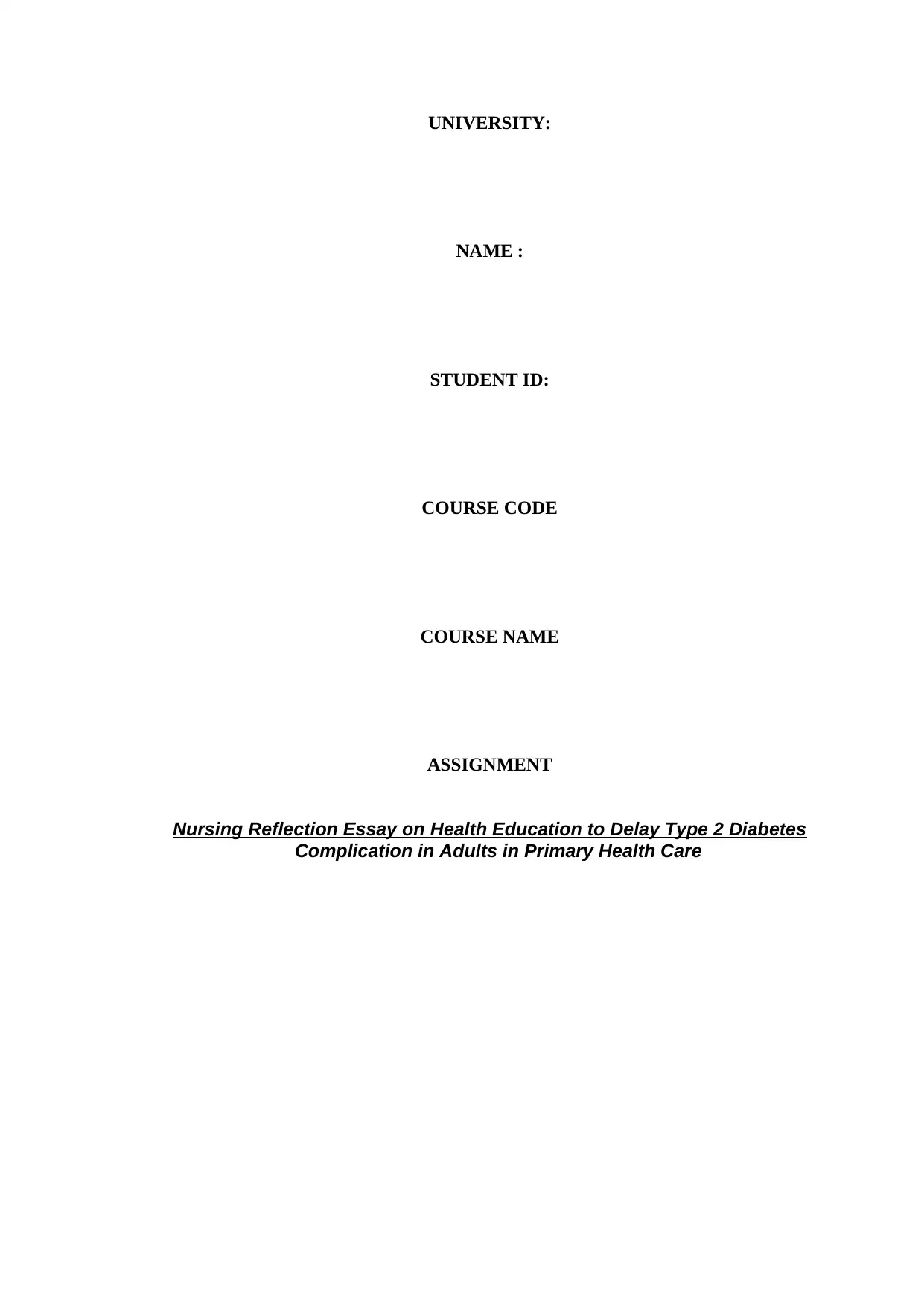
UNIVERSITY:
NAME :
STUDENT ID:
COURSE CODE
COURSE NAME
ASSIGNMENT
Nursing Reflection Essay on Health Education to Delay Type 2 Diabetes
Complication in Adults in Primary Health Care
NAME :
STUDENT ID:
COURSE CODE
COURSE NAME
ASSIGNMENT
Nursing Reflection Essay on Health Education to Delay Type 2 Diabetes
Complication in Adults in Primary Health Care
Paraphrase This Document
Need a fresh take? Get an instant paraphrase of this document with our AI Paraphraser
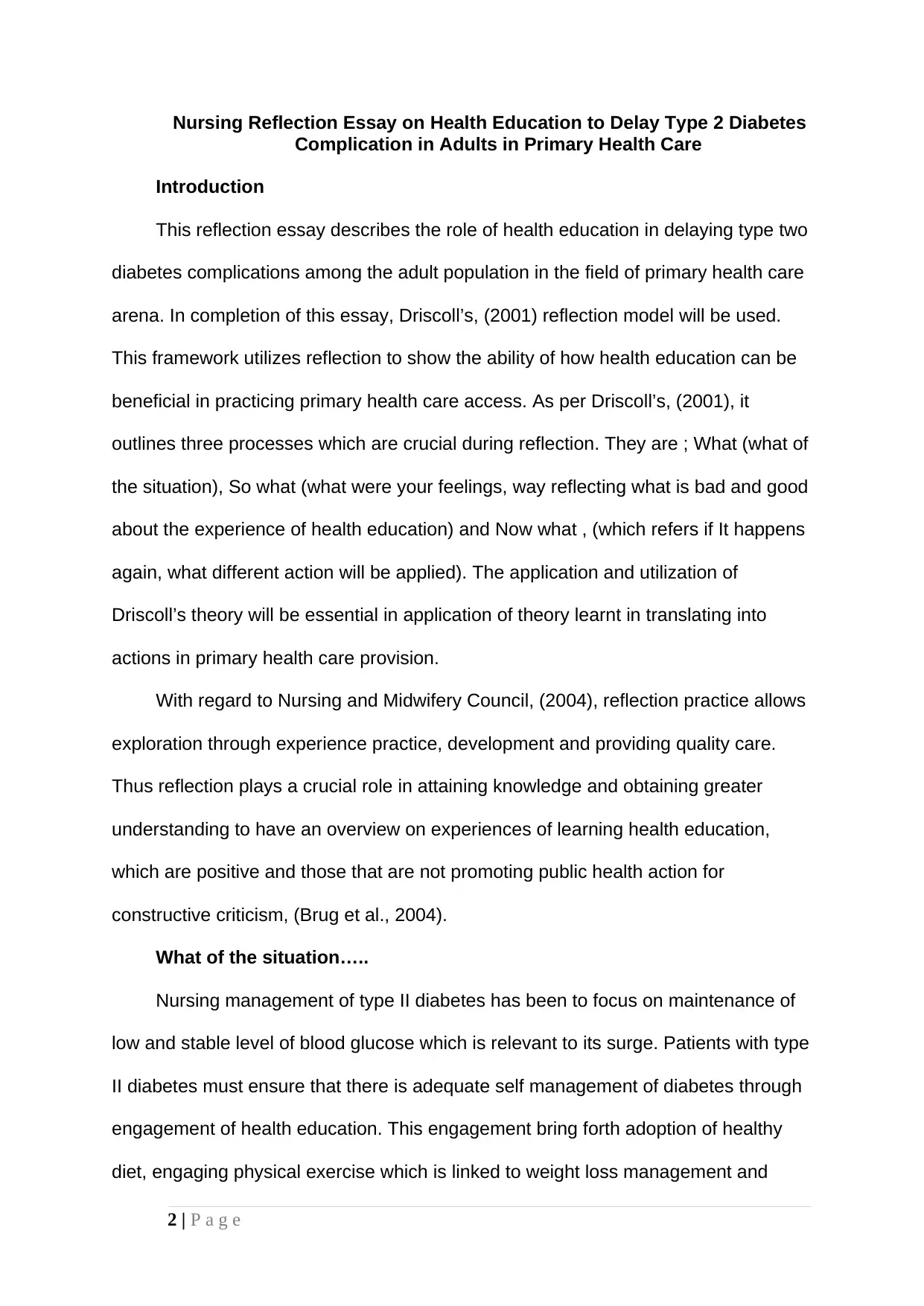
Nursing Reflection Essay on Health Education to Delay Type 2 Diabetes
Complication in Adults in Primary Health Care
Introduction
This reflection essay describes the role of health education in delaying type two
diabetes complications among the adult population in the field of primary health care
arena. In completion of this essay, Driscoll’s, (2001) reflection model will be used.
This framework utilizes reflection to show the ability of how health education can be
beneficial in practicing primary health care access. As per Driscoll’s, (2001), it
outlines three processes which are crucial during reflection. They are ; What (what of
the situation), So what (what were your feelings, way reflecting what is bad and good
about the experience of health education) and Now what , (which refers if It happens
again, what different action will be applied). The application and utilization of
Driscoll’s theory will be essential in application of theory learnt in translating into
actions in primary health care provision.
With regard to Nursing and Midwifery Council, (2004), reflection practice allows
exploration through experience practice, development and providing quality care.
Thus reflection plays a crucial role in attaining knowledge and obtaining greater
understanding to have an overview on experiences of learning health education,
which are positive and those that are not promoting public health action for
constructive criticism, (Brug et al., 2004).
What of the situation…..
Nursing management of type II diabetes has been to focus on maintenance of
low and stable level of blood glucose which is relevant to its surge. Patients with type
II diabetes must ensure that there is adequate self management of diabetes through
engagement of health education. This engagement bring forth adoption of healthy
diet, engaging physical exercise which is linked to weight loss management and
2 | P a g e
Complication in Adults in Primary Health Care
Introduction
This reflection essay describes the role of health education in delaying type two
diabetes complications among the adult population in the field of primary health care
arena. In completion of this essay, Driscoll’s, (2001) reflection model will be used.
This framework utilizes reflection to show the ability of how health education can be
beneficial in practicing primary health care access. As per Driscoll’s, (2001), it
outlines three processes which are crucial during reflection. They are ; What (what of
the situation), So what (what were your feelings, way reflecting what is bad and good
about the experience of health education) and Now what , (which refers if It happens
again, what different action will be applied). The application and utilization of
Driscoll’s theory will be essential in application of theory learnt in translating into
actions in primary health care provision.
With regard to Nursing and Midwifery Council, (2004), reflection practice allows
exploration through experience practice, development and providing quality care.
Thus reflection plays a crucial role in attaining knowledge and obtaining greater
understanding to have an overview on experiences of learning health education,
which are positive and those that are not promoting public health action for
constructive criticism, (Brug et al., 2004).
What of the situation…..
Nursing management of type II diabetes has been to focus on maintenance of
low and stable level of blood glucose which is relevant to its surge. Patients with type
II diabetes must ensure that there is adequate self management of diabetes through
engagement of health education. This engagement bring forth adoption of healthy
diet, engaging physical exercise which is linked to weight loss management and
2 | P a g e
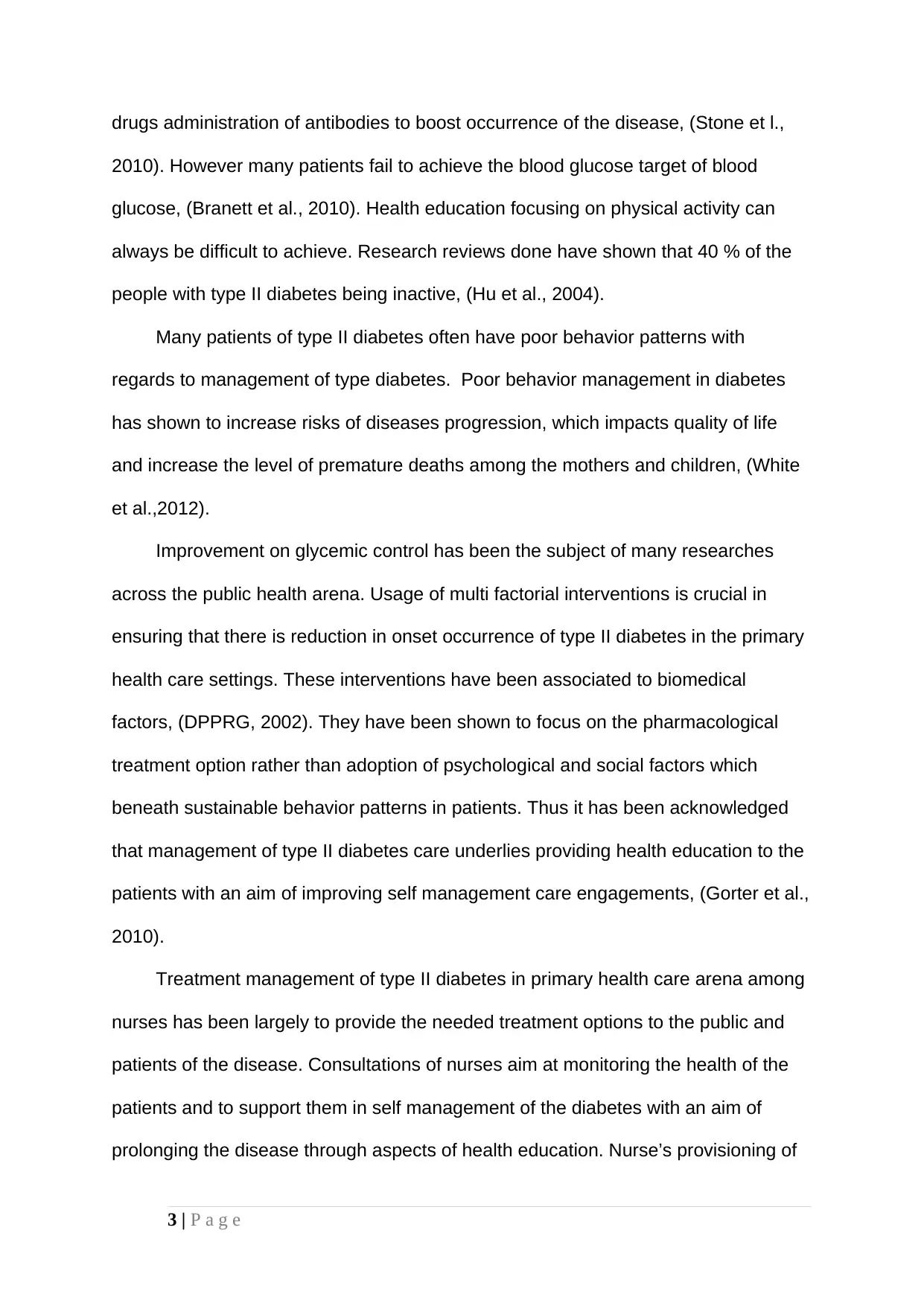
drugs administration of antibodies to boost occurrence of the disease, (Stone et l.,
2010). However many patients fail to achieve the blood glucose target of blood
glucose, (Branett et al., 2010). Health education focusing on physical activity can
always be difficult to achieve. Research reviews done have shown that 40 % of the
people with type II diabetes being inactive, (Hu et al., 2004).
Many patients of type II diabetes often have poor behavior patterns with
regards to management of type diabetes. Poor behavior management in diabetes
has shown to increase risks of diseases progression, which impacts quality of life
and increase the level of premature deaths among the mothers and children, (White
et al.,2012).
Improvement on glycemic control has been the subject of many researches
across the public health arena. Usage of multi factorial interventions is crucial in
ensuring that there is reduction in onset occurrence of type II diabetes in the primary
health care settings. These interventions have been associated to biomedical
factors, (DPPRG, 2002). They have been shown to focus on the pharmacological
treatment option rather than adoption of psychological and social factors which
beneath sustainable behavior patterns in patients. Thus it has been acknowledged
that management of type II diabetes care underlies providing health education to the
patients with an aim of improving self management care engagements, (Gorter et al.,
2010).
Treatment management of type II diabetes in primary health care arena among
nurses has been largely to provide the needed treatment options to the public and
patients of the disease. Consultations of nurses aim at monitoring the health of the
patients and to support them in self management of the diabetes with an aim of
prolonging the disease through aspects of health education. Nurse’s provisioning of
3 | P a g e
2010). However many patients fail to achieve the blood glucose target of blood
glucose, (Branett et al., 2010). Health education focusing on physical activity can
always be difficult to achieve. Research reviews done have shown that 40 % of the
people with type II diabetes being inactive, (Hu et al., 2004).
Many patients of type II diabetes often have poor behavior patterns with
regards to management of type diabetes. Poor behavior management in diabetes
has shown to increase risks of diseases progression, which impacts quality of life
and increase the level of premature deaths among the mothers and children, (White
et al.,2012).
Improvement on glycemic control has been the subject of many researches
across the public health arena. Usage of multi factorial interventions is crucial in
ensuring that there is reduction in onset occurrence of type II diabetes in the primary
health care settings. These interventions have been associated to biomedical
factors, (DPPRG, 2002). They have been shown to focus on the pharmacological
treatment option rather than adoption of psychological and social factors which
beneath sustainable behavior patterns in patients. Thus it has been acknowledged
that management of type II diabetes care underlies providing health education to the
patients with an aim of improving self management care engagements, (Gorter et al.,
2010).
Treatment management of type II diabetes in primary health care arena among
nurses has been largely to provide the needed treatment options to the public and
patients of the disease. Consultations of nurses aim at monitoring the health of the
patients and to support them in self management of the diabetes with an aim of
prolonging the disease through aspects of health education. Nurse’s provisioning of
3 | P a g e
⊘ This is a preview!⊘
Do you want full access?
Subscribe today to unlock all pages.

Trusted by 1+ million students worldwide
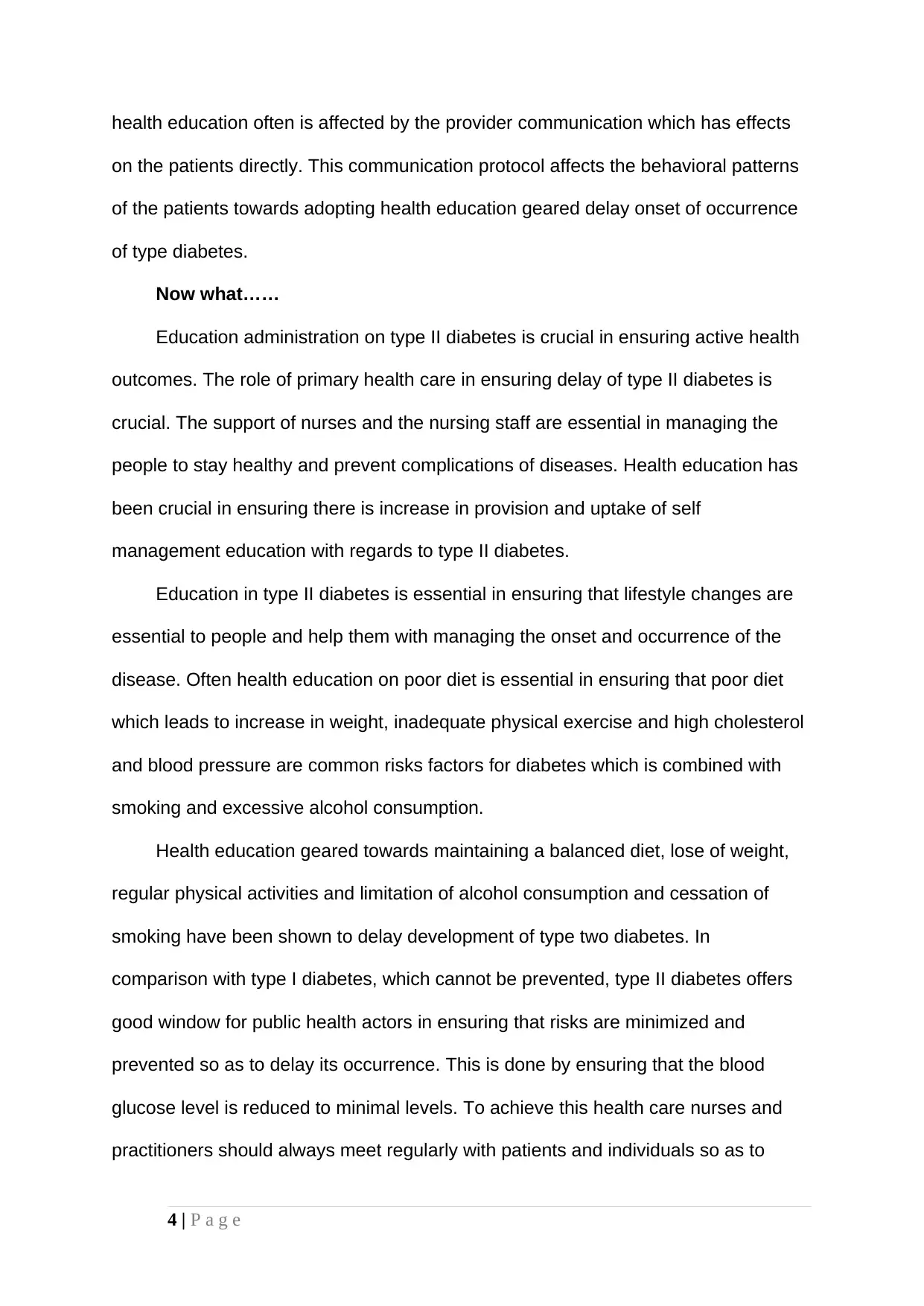
health education often is affected by the provider communication which has effects
on the patients directly. This communication protocol affects the behavioral patterns
of the patients towards adopting health education geared delay onset of occurrence
of type diabetes.
Now what……
Education administration on type II diabetes is crucial in ensuring active health
outcomes. The role of primary health care in ensuring delay of type II diabetes is
crucial. The support of nurses and the nursing staff are essential in managing the
people to stay healthy and prevent complications of diseases. Health education has
been crucial in ensuring there is increase in provision and uptake of self
management education with regards to type II diabetes.
Education in type II diabetes is essential in ensuring that lifestyle changes are
essential to people and help them with managing the onset and occurrence of the
disease. Often health education on poor diet is essential in ensuring that poor diet
which leads to increase in weight, inadequate physical exercise and high cholesterol
and blood pressure are common risks factors for diabetes which is combined with
smoking and excessive alcohol consumption.
Health education geared towards maintaining a balanced diet, lose of weight,
regular physical activities and limitation of alcohol consumption and cessation of
smoking have been shown to delay development of type two diabetes. In
comparison with type I diabetes, which cannot be prevented, type II diabetes offers
good window for public health actors in ensuring that risks are minimized and
prevented so as to delay its occurrence. This is done by ensuring that the blood
glucose level is reduced to minimal levels. To achieve this health care nurses and
practitioners should always meet regularly with patients and individuals so as to
4 | P a g e
on the patients directly. This communication protocol affects the behavioral patterns
of the patients towards adopting health education geared delay onset of occurrence
of type diabetes.
Now what……
Education administration on type II diabetes is crucial in ensuring active health
outcomes. The role of primary health care in ensuring delay of type II diabetes is
crucial. The support of nurses and the nursing staff are essential in managing the
people to stay healthy and prevent complications of diseases. Health education has
been crucial in ensuring there is increase in provision and uptake of self
management education with regards to type II diabetes.
Education in type II diabetes is essential in ensuring that lifestyle changes are
essential to people and help them with managing the onset and occurrence of the
disease. Often health education on poor diet is essential in ensuring that poor diet
which leads to increase in weight, inadequate physical exercise and high cholesterol
and blood pressure are common risks factors for diabetes which is combined with
smoking and excessive alcohol consumption.
Health education geared towards maintaining a balanced diet, lose of weight,
regular physical activities and limitation of alcohol consumption and cessation of
smoking have been shown to delay development of type two diabetes. In
comparison with type I diabetes, which cannot be prevented, type II diabetes offers
good window for public health actors in ensuring that risks are minimized and
prevented so as to delay its occurrence. This is done by ensuring that the blood
glucose level is reduced to minimal levels. To achieve this health care nurses and
practitioners should always meet regularly with patients and individuals so as to
4 | P a g e
Paraphrase This Document
Need a fresh take? Get an instant paraphrase of this document with our AI Paraphraser
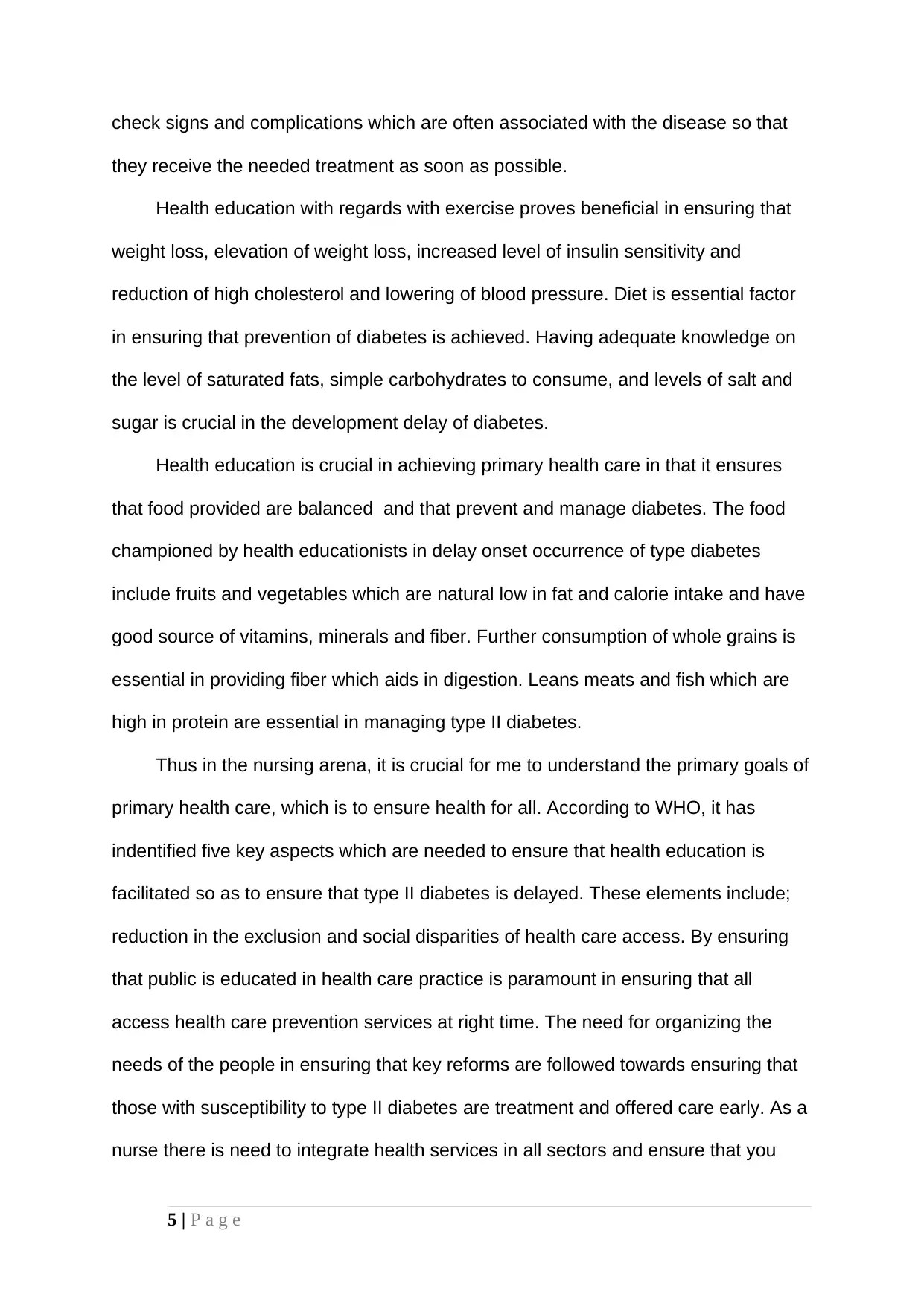
check signs and complications which are often associated with the disease so that
they receive the needed treatment as soon as possible.
Health education with regards with exercise proves beneficial in ensuring that
weight loss, elevation of weight loss, increased level of insulin sensitivity and
reduction of high cholesterol and lowering of blood pressure. Diet is essential factor
in ensuring that prevention of diabetes is achieved. Having adequate knowledge on
the level of saturated fats, simple carbohydrates to consume, and levels of salt and
sugar is crucial in the development delay of diabetes.
Health education is crucial in achieving primary health care in that it ensures
that food provided are balanced and that prevent and manage diabetes. The food
championed by health educationists in delay onset occurrence of type diabetes
include fruits and vegetables which are natural low in fat and calorie intake and have
good source of vitamins, minerals and fiber. Further consumption of whole grains is
essential in providing fiber which aids in digestion. Leans meats and fish which are
high in protein are essential in managing type II diabetes.
Thus in the nursing arena, it is crucial for me to understand the primary goals of
primary health care, which is to ensure health for all. According to WHO, it has
indentified five key aspects which are needed to ensure that health education is
facilitated so as to ensure that type II diabetes is delayed. These elements include;
reduction in the exclusion and social disparities of health care access. By ensuring
that public is educated in health care practice is paramount in ensuring that all
access health care prevention services at right time. The need for organizing the
needs of the people in ensuring that key reforms are followed towards ensuring that
those with susceptibility to type II diabetes are treatment and offered care early. As a
nurse there is need to integrate health services in all sectors and ensure that you
5 | P a g e
they receive the needed treatment as soon as possible.
Health education with regards with exercise proves beneficial in ensuring that
weight loss, elevation of weight loss, increased level of insulin sensitivity and
reduction of high cholesterol and lowering of blood pressure. Diet is essential factor
in ensuring that prevention of diabetes is achieved. Having adequate knowledge on
the level of saturated fats, simple carbohydrates to consume, and levels of salt and
sugar is crucial in the development delay of diabetes.
Health education is crucial in achieving primary health care in that it ensures
that food provided are balanced and that prevent and manage diabetes. The food
championed by health educationists in delay onset occurrence of type diabetes
include fruits and vegetables which are natural low in fat and calorie intake and have
good source of vitamins, minerals and fiber. Further consumption of whole grains is
essential in providing fiber which aids in digestion. Leans meats and fish which are
high in protein are essential in managing type II diabetes.
Thus in the nursing arena, it is crucial for me to understand the primary goals of
primary health care, which is to ensure health for all. According to WHO, it has
indentified five key aspects which are needed to ensure that health education is
facilitated so as to ensure that type II diabetes is delayed. These elements include;
reduction in the exclusion and social disparities of health care access. By ensuring
that public is educated in health care practice is paramount in ensuring that all
access health care prevention services at right time. The need for organizing the
needs of the people in ensuring that key reforms are followed towards ensuring that
those with susceptibility to type II diabetes are treatment and offered care early. As a
nurse there is need to integrate health services in all sectors and ensure that you
5 | P a g e
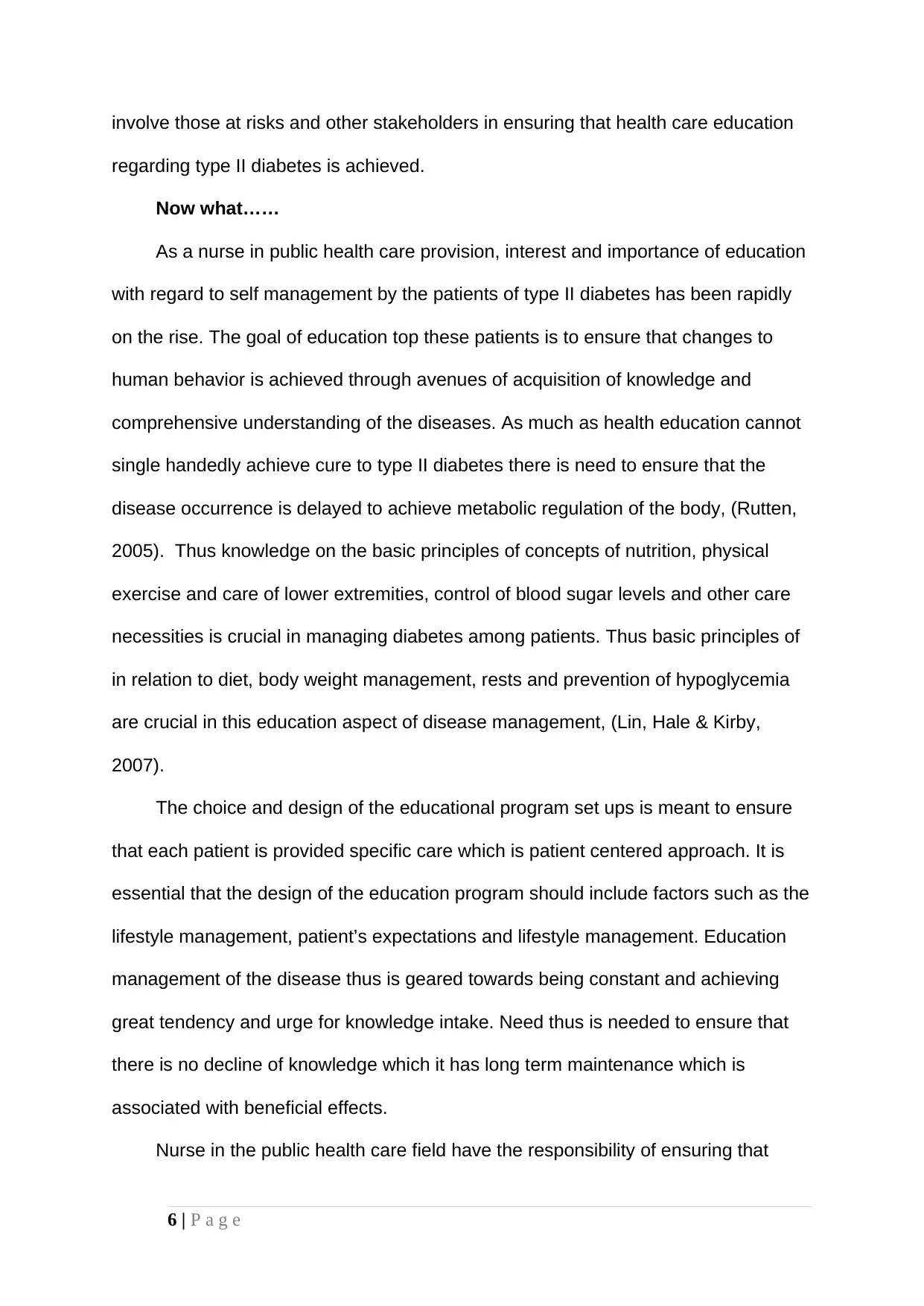
involve those at risks and other stakeholders in ensuring that health care education
regarding type II diabetes is achieved.
Now what……
As a nurse in public health care provision, interest and importance of education
with regard to self management by the patients of type II diabetes has been rapidly
on the rise. The goal of education top these patients is to ensure that changes to
human behavior is achieved through avenues of acquisition of knowledge and
comprehensive understanding of the diseases. As much as health education cannot
single handedly achieve cure to type II diabetes there is need to ensure that the
disease occurrence is delayed to achieve metabolic regulation of the body, (Rutten,
2005). Thus knowledge on the basic principles of concepts of nutrition, physical
exercise and care of lower extremities, control of blood sugar levels and other care
necessities is crucial in managing diabetes among patients. Thus basic principles of
in relation to diet, body weight management, rests and prevention of hypoglycemia
are crucial in this education aspect of disease management, (Lin, Hale & Kirby,
2007).
The choice and design of the educational program set ups is meant to ensure
that each patient is provided specific care which is patient centered approach. It is
essential that the design of the education program should include factors such as the
lifestyle management, patient’s expectations and lifestyle management. Education
management of the disease thus is geared towards being constant and achieving
great tendency and urge for knowledge intake. Need thus is needed to ensure that
there is no decline of knowledge which it has long term maintenance which is
associated with beneficial effects.
Nurse in the public health care field have the responsibility of ensuring that
6 | P a g e
regarding type II diabetes is achieved.
Now what……
As a nurse in public health care provision, interest and importance of education
with regard to self management by the patients of type II diabetes has been rapidly
on the rise. The goal of education top these patients is to ensure that changes to
human behavior is achieved through avenues of acquisition of knowledge and
comprehensive understanding of the diseases. As much as health education cannot
single handedly achieve cure to type II diabetes there is need to ensure that the
disease occurrence is delayed to achieve metabolic regulation of the body, (Rutten,
2005). Thus knowledge on the basic principles of concepts of nutrition, physical
exercise and care of lower extremities, control of blood sugar levels and other care
necessities is crucial in managing diabetes among patients. Thus basic principles of
in relation to diet, body weight management, rests and prevention of hypoglycemia
are crucial in this education aspect of disease management, (Lin, Hale & Kirby,
2007).
The choice and design of the educational program set ups is meant to ensure
that each patient is provided specific care which is patient centered approach. It is
essential that the design of the education program should include factors such as the
lifestyle management, patient’s expectations and lifestyle management. Education
management of the disease thus is geared towards being constant and achieving
great tendency and urge for knowledge intake. Need thus is needed to ensure that
there is no decline of knowledge which it has long term maintenance which is
associated with beneficial effects.
Nurse in the public health care field have the responsibility of ensuring that
6 | P a g e
⊘ This is a preview!⊘
Do you want full access?
Subscribe today to unlock all pages.

Trusted by 1+ million students worldwide
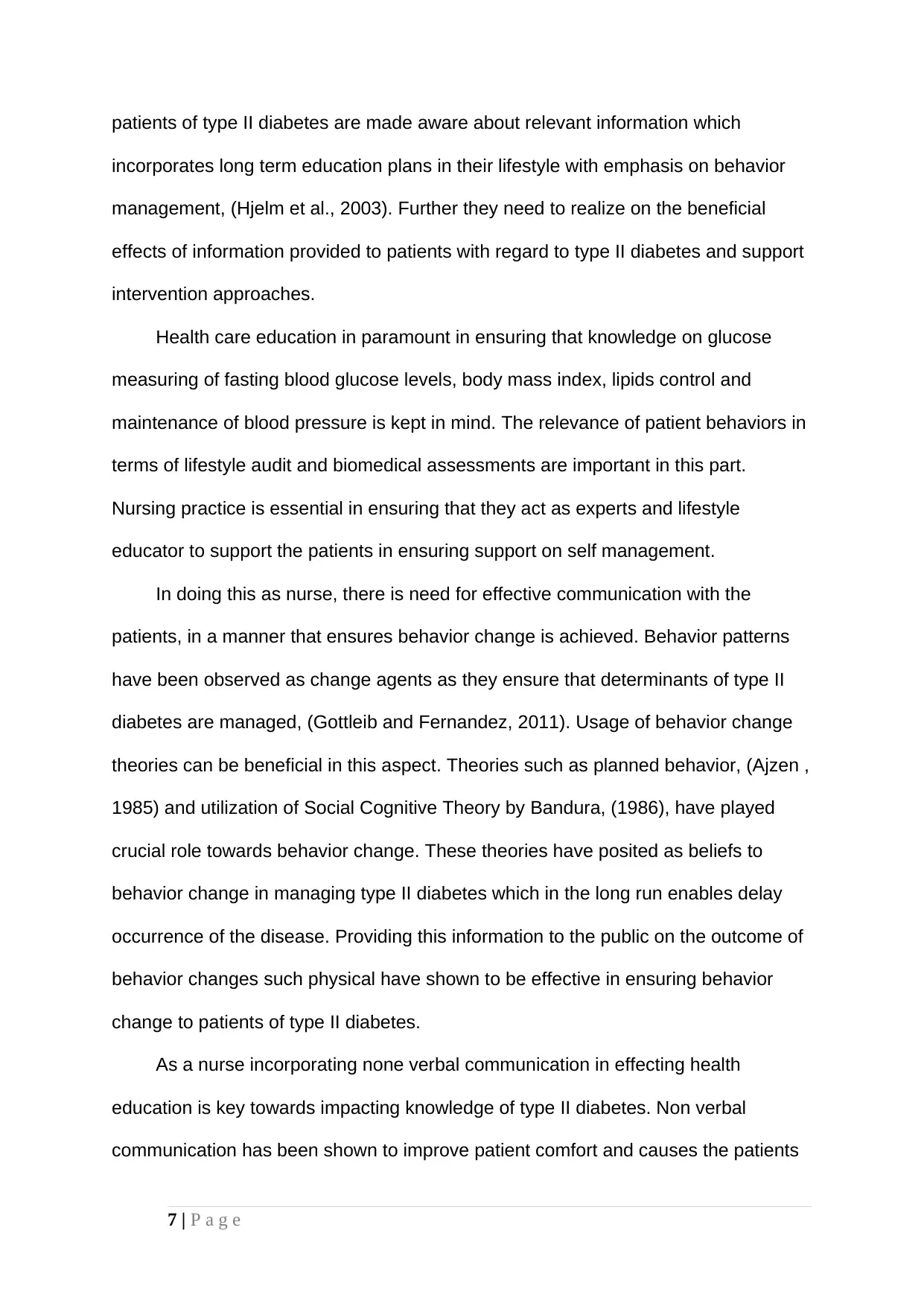
patients of type II diabetes are made aware about relevant information which
incorporates long term education plans in their lifestyle with emphasis on behavior
management, (Hjelm et al., 2003). Further they need to realize on the beneficial
effects of information provided to patients with regard to type II diabetes and support
intervention approaches.
Health care education in paramount in ensuring that knowledge on glucose
measuring of fasting blood glucose levels, body mass index, lipids control and
maintenance of blood pressure is kept in mind. The relevance of patient behaviors in
terms of lifestyle audit and biomedical assessments are important in this part.
Nursing practice is essential in ensuring that they act as experts and lifestyle
educator to support the patients in ensuring support on self management.
In doing this as nurse, there is need for effective communication with the
patients, in a manner that ensures behavior change is achieved. Behavior patterns
have been observed as change agents as they ensure that determinants of type II
diabetes are managed, (Gottleib and Fernandez, 2011). Usage of behavior change
theories can be beneficial in this aspect. Theories such as planned behavior, (Ajzen ,
1985) and utilization of Social Cognitive Theory by Bandura, (1986), have played
crucial role towards behavior change. These theories have posited as beliefs to
behavior change in managing type II diabetes which in the long run enables delay
occurrence of the disease. Providing this information to the public on the outcome of
behavior changes such physical have shown to be effective in ensuring behavior
change to patients of type II diabetes.
As a nurse incorporating none verbal communication in effecting health
education is key towards impacting knowledge of type II diabetes. Non verbal
communication has been shown to improve patient comfort and causes the patients
7 | P a g e
incorporates long term education plans in their lifestyle with emphasis on behavior
management, (Hjelm et al., 2003). Further they need to realize on the beneficial
effects of information provided to patients with regard to type II diabetes and support
intervention approaches.
Health care education in paramount in ensuring that knowledge on glucose
measuring of fasting blood glucose levels, body mass index, lipids control and
maintenance of blood pressure is kept in mind. The relevance of patient behaviors in
terms of lifestyle audit and biomedical assessments are important in this part.
Nursing practice is essential in ensuring that they act as experts and lifestyle
educator to support the patients in ensuring support on self management.
In doing this as nurse, there is need for effective communication with the
patients, in a manner that ensures behavior change is achieved. Behavior patterns
have been observed as change agents as they ensure that determinants of type II
diabetes are managed, (Gottleib and Fernandez, 2011). Usage of behavior change
theories can be beneficial in this aspect. Theories such as planned behavior, (Ajzen ,
1985) and utilization of Social Cognitive Theory by Bandura, (1986), have played
crucial role towards behavior change. These theories have posited as beliefs to
behavior change in managing type II diabetes which in the long run enables delay
occurrence of the disease. Providing this information to the public on the outcome of
behavior changes such physical have shown to be effective in ensuring behavior
change to patients of type II diabetes.
As a nurse incorporating none verbal communication in effecting health
education is key towards impacting knowledge of type II diabetes. Non verbal
communication has been shown to improve patient comfort and causes the patients
7 | P a g e
Paraphrase This Document
Need a fresh take? Get an instant paraphrase of this document with our AI Paraphraser
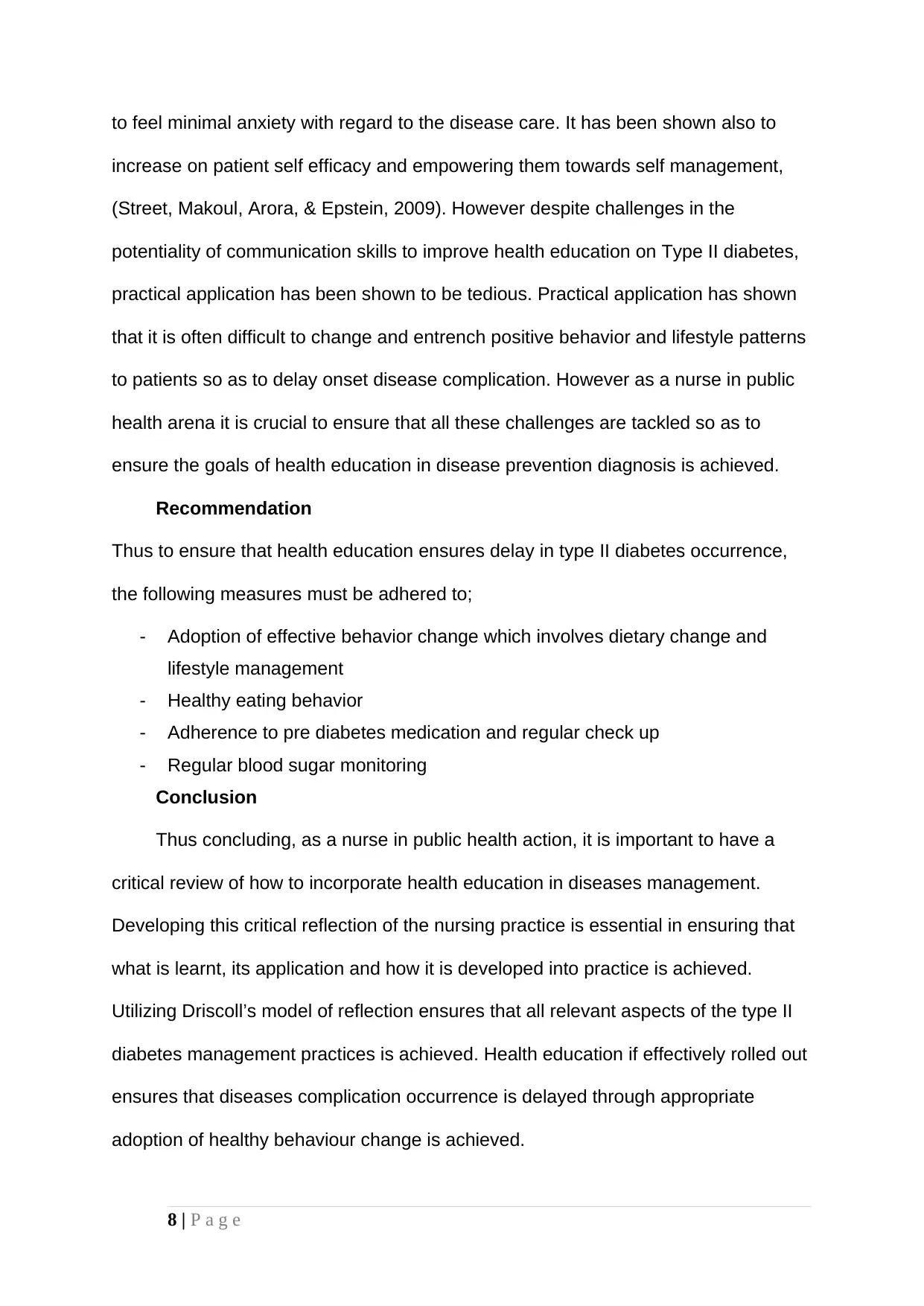
to feel minimal anxiety with regard to the disease care. It has been shown also to
increase on patient self efficacy and empowering them towards self management,
(Street, Makoul, Arora, & Epstein, 2009). However despite challenges in the
potentiality of communication skills to improve health education on Type II diabetes,
practical application has been shown to be tedious. Practical application has shown
that it is often difficult to change and entrench positive behavior and lifestyle patterns
to patients so as to delay onset disease complication. However as a nurse in public
health arena it is crucial to ensure that all these challenges are tackled so as to
ensure the goals of health education in disease prevention diagnosis is achieved.
Recommendation
Thus to ensure that health education ensures delay in type II diabetes occurrence,
the following measures must be adhered to;
- Adoption of effective behavior change which involves dietary change and
lifestyle management
- Healthy eating behavior
- Adherence to pre diabetes medication and regular check up
- Regular blood sugar monitoring
Conclusion
Thus concluding, as a nurse in public health action, it is important to have a
critical review of how to incorporate health education in diseases management.
Developing this critical reflection of the nursing practice is essential in ensuring that
what is learnt, its application and how it is developed into practice is achieved.
Utilizing Driscoll’s model of reflection ensures that all relevant aspects of the type II
diabetes management practices is achieved. Health education if effectively rolled out
ensures that diseases complication occurrence is delayed through appropriate
adoption of healthy behaviour change is achieved.
8 | P a g e
increase on patient self efficacy and empowering them towards self management,
(Street, Makoul, Arora, & Epstein, 2009). However despite challenges in the
potentiality of communication skills to improve health education on Type II diabetes,
practical application has been shown to be tedious. Practical application has shown
that it is often difficult to change and entrench positive behavior and lifestyle patterns
to patients so as to delay onset disease complication. However as a nurse in public
health arena it is crucial to ensure that all these challenges are tackled so as to
ensure the goals of health education in disease prevention diagnosis is achieved.
Recommendation
Thus to ensure that health education ensures delay in type II diabetes occurrence,
the following measures must be adhered to;
- Adoption of effective behavior change which involves dietary change and
lifestyle management
- Healthy eating behavior
- Adherence to pre diabetes medication and regular check up
- Regular blood sugar monitoring
Conclusion
Thus concluding, as a nurse in public health action, it is important to have a
critical review of how to incorporate health education in diseases management.
Developing this critical reflection of the nursing practice is essential in ensuring that
what is learnt, its application and how it is developed into practice is achieved.
Utilizing Driscoll’s model of reflection ensures that all relevant aspects of the type II
diabetes management practices is achieved. Health education if effectively rolled out
ensures that diseases complication occurrence is delayed through appropriate
adoption of healthy behaviour change is achieved.
8 | P a g e
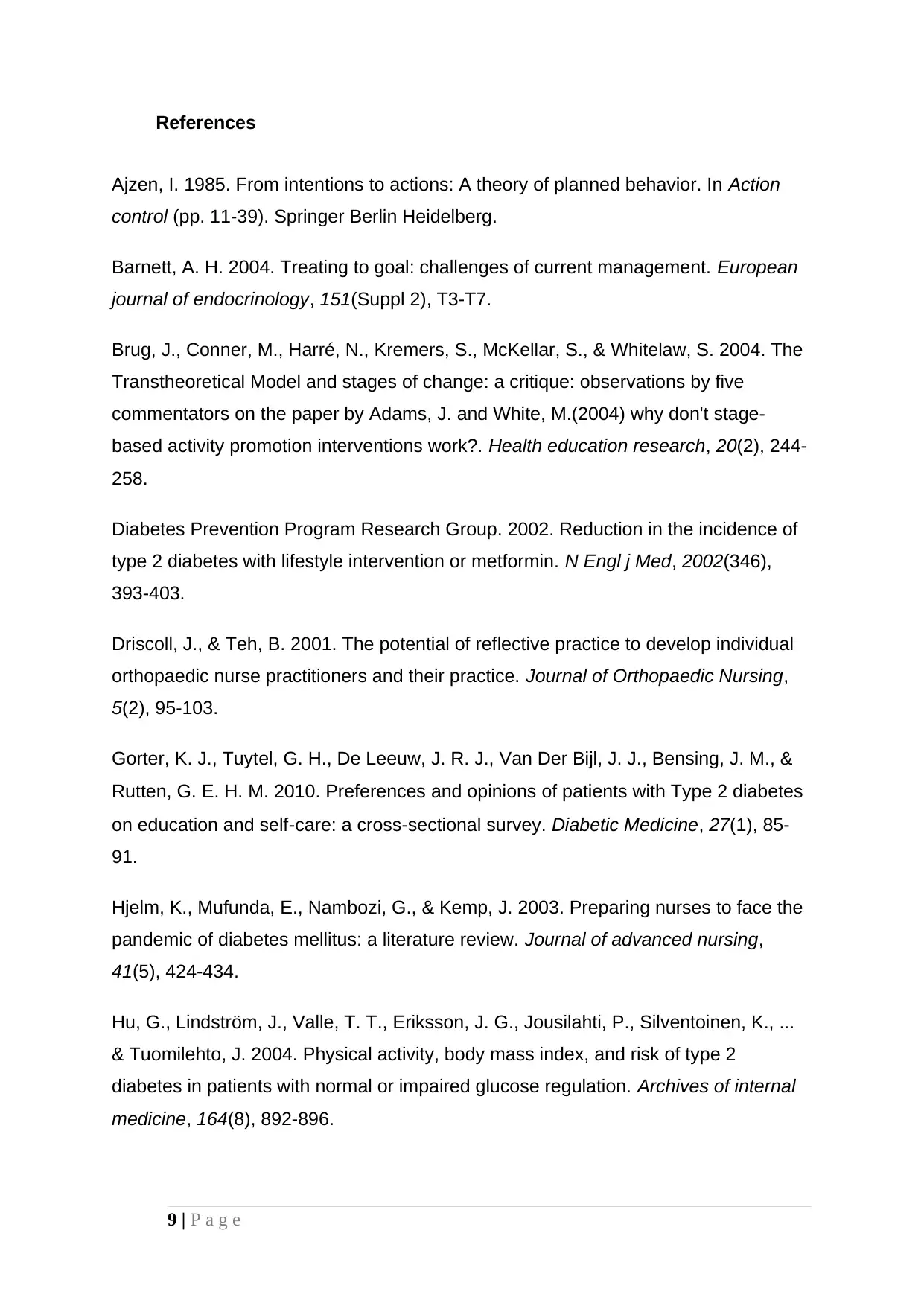
References
Ajzen, I. 1985. From intentions to actions: A theory of planned behavior. In Action
control (pp. 11-39). Springer Berlin Heidelberg.
Barnett, A. H. 2004. Treating to goal: challenges of current management. European
journal of endocrinology, 151(Suppl 2), T3-T7.
Brug, J., Conner, M., Harré, N., Kremers, S., McKellar, S., & Whitelaw, S. 2004. The
Transtheoretical Model and stages of change: a critique: observations by five
commentators on the paper by Adams, J. and White, M.(2004) why don't stage-
based activity promotion interventions work?. Health education research, 20(2), 244-
258.
Diabetes Prevention Program Research Group. 2002. Reduction in the incidence of
type 2 diabetes with lifestyle intervention or metformin. N Engl j Med, 2002(346),
393-403.
Driscoll, J., & Teh, B. 2001. The potential of reflective practice to develop individual
orthopaedic nurse practitioners and their practice. Journal of Orthopaedic Nursing,
5(2), 95-103.
Gorter, K. J., Tuytel, G. H., De Leeuw, J. R. J., Van Der Bijl, J. J., Bensing, J. M., &
Rutten, G. E. H. M. 2010. Preferences and opinions of patients with Type 2 diabetes
on education and self‐care: a cross‐sectional survey. Diabetic Medicine, 27(1), 85-
91.
Hjelm, K., Mufunda, E., Nambozi, G., & Kemp, J. 2003. Preparing nurses to face the
pandemic of diabetes mellitus: a literature review. Journal of advanced nursing,
41(5), 424-434.
Hu, G., Lindström, J., Valle, T. T., Eriksson, J. G., Jousilahti, P., Silventoinen, K., ...
& Tuomilehto, J. 2004. Physical activity, body mass index, and risk of type 2
diabetes in patients with normal or impaired glucose regulation. Archives of internal
medicine, 164(8), 892-896.
9 | P a g e
Ajzen, I. 1985. From intentions to actions: A theory of planned behavior. In Action
control (pp. 11-39). Springer Berlin Heidelberg.
Barnett, A. H. 2004. Treating to goal: challenges of current management. European
journal of endocrinology, 151(Suppl 2), T3-T7.
Brug, J., Conner, M., Harré, N., Kremers, S., McKellar, S., & Whitelaw, S. 2004. The
Transtheoretical Model and stages of change: a critique: observations by five
commentators on the paper by Adams, J. and White, M.(2004) why don't stage-
based activity promotion interventions work?. Health education research, 20(2), 244-
258.
Diabetes Prevention Program Research Group. 2002. Reduction in the incidence of
type 2 diabetes with lifestyle intervention or metformin. N Engl j Med, 2002(346),
393-403.
Driscoll, J., & Teh, B. 2001. The potential of reflective practice to develop individual
orthopaedic nurse practitioners and their practice. Journal of Orthopaedic Nursing,
5(2), 95-103.
Gorter, K. J., Tuytel, G. H., De Leeuw, J. R. J., Van Der Bijl, J. J., Bensing, J. M., &
Rutten, G. E. H. M. 2010. Preferences and opinions of patients with Type 2 diabetes
on education and self‐care: a cross‐sectional survey. Diabetic Medicine, 27(1), 85-
91.
Hjelm, K., Mufunda, E., Nambozi, G., & Kemp, J. 2003. Preparing nurses to face the
pandemic of diabetes mellitus: a literature review. Journal of advanced nursing,
41(5), 424-434.
Hu, G., Lindström, J., Valle, T. T., Eriksson, J. G., Jousilahti, P., Silventoinen, K., ...
& Tuomilehto, J. 2004. Physical activity, body mass index, and risk of type 2
diabetes in patients with normal or impaired glucose regulation. Archives of internal
medicine, 164(8), 892-896.
9 | P a g e
⊘ This is a preview!⊘
Do you want full access?
Subscribe today to unlock all pages.

Trusted by 1+ million students worldwide
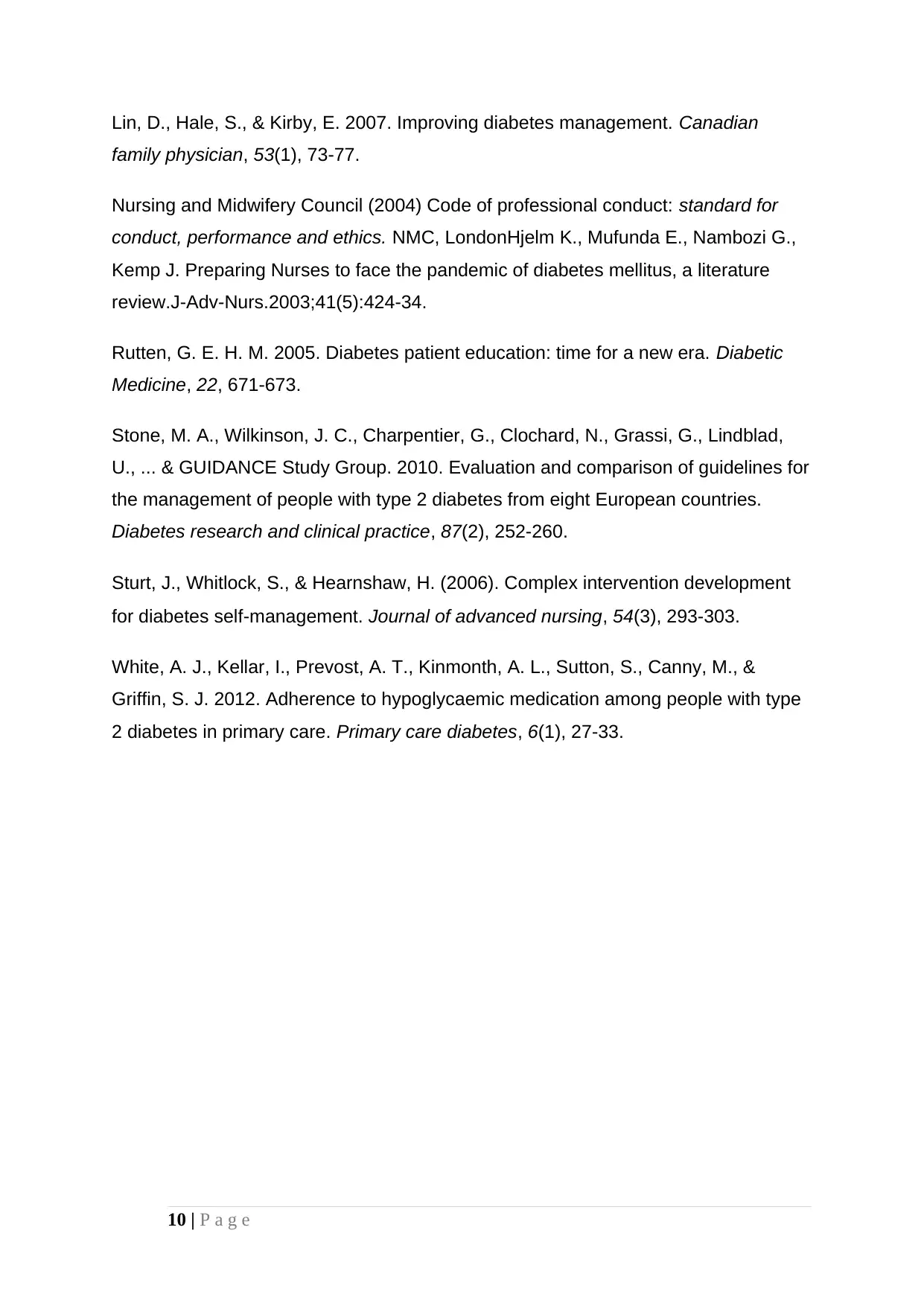
Lin, D., Hale, S., & Kirby, E. 2007. Improving diabetes management. Canadian
family physician, 53(1), 73-77.
Nursing and Midwifery Council (2004) Code of professional conduct: standard for
conduct, performance and ethics. NMC, LondonHjelm K., Mufunda E., Nambozi G.,
Kemp J. Preparing Nurses to face the pandemic of diabetes mellitus, a literature
review.J-Adv-Nurs.2003;41(5):424-34.
Rutten, G. E. H. M. 2005. Diabetes patient education: time for a new era. Diabetic
Medicine, 22, 671-673.
Stone, M. A., Wilkinson, J. C., Charpentier, G., Clochard, N., Grassi, G., Lindblad,
U., ... & GUIDANCE Study Group. 2010. Evaluation and comparison of guidelines for
the management of people with type 2 diabetes from eight European countries.
Diabetes research and clinical practice, 87(2), 252-260.
Sturt, J., Whitlock, S., & Hearnshaw, H. (2006). Complex intervention development
for diabetes self‐management. Journal of advanced nursing, 54(3), 293-303.
White, A. J., Kellar, I., Prevost, A. T., Kinmonth, A. L., Sutton, S., Canny, M., &
Griffin, S. J. 2012. Adherence to hypoglycaemic medication among people with type
2 diabetes in primary care. Primary care diabetes, 6(1), 27-33.
10 | P a g e
family physician, 53(1), 73-77.
Nursing and Midwifery Council (2004) Code of professional conduct: standard for
conduct, performance and ethics. NMC, LondonHjelm K., Mufunda E., Nambozi G.,
Kemp J. Preparing Nurses to face the pandemic of diabetes mellitus, a literature
review.J-Adv-Nurs.2003;41(5):424-34.
Rutten, G. E. H. M. 2005. Diabetes patient education: time for a new era. Diabetic
Medicine, 22, 671-673.
Stone, M. A., Wilkinson, J. C., Charpentier, G., Clochard, N., Grassi, G., Lindblad,
U., ... & GUIDANCE Study Group. 2010. Evaluation and comparison of guidelines for
the management of people with type 2 diabetes from eight European countries.
Diabetes research and clinical practice, 87(2), 252-260.
Sturt, J., Whitlock, S., & Hearnshaw, H. (2006). Complex intervention development
for diabetes self‐management. Journal of advanced nursing, 54(3), 293-303.
White, A. J., Kellar, I., Prevost, A. T., Kinmonth, A. L., Sutton, S., Canny, M., &
Griffin, S. J. 2012. Adherence to hypoglycaemic medication among people with type
2 diabetes in primary care. Primary care diabetes, 6(1), 27-33.
10 | P a g e
1 out of 10
Related Documents
Your All-in-One AI-Powered Toolkit for Academic Success.
+13062052269
info@desklib.com
Available 24*7 on WhatsApp / Email
![[object Object]](/_next/static/media/star-bottom.7253800d.svg)
Unlock your academic potential
Copyright © 2020–2025 A2Z Services. All Rights Reserved. Developed and managed by ZUCOL.





